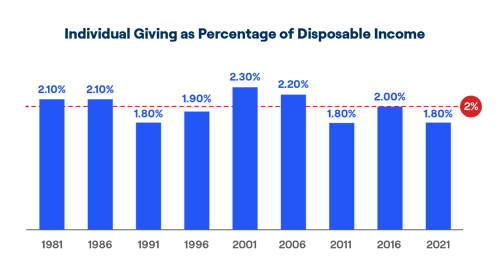What Does it Mean to Close the Loop?
Every NPO aspires to create a donor base that is recurring and sustainable. Nonprofits don’t close the loop well, which is why 75%-80% of donors...

Use no-code tools to quickly build donation page variants, launch A/B tests, and get clear results that help you drive more donor conversions with a single platform.
New to online donation pages for your nonprofit? Start here.
Donation page A/B testing - no science degree needed.
Keep your donation page loading fast - and drive higher conversions.

Nonprofits have had little success solving the so-called “2% dilemma.” As you see in the graphic below, the total amount of giving in the U.S. has hovered at around 2% of America’s disposable income, and that figure hasn’t budged in decades.
 Growing that number will require a substantial change in how nonprofits think, how that translates into a culture (a clear sense of purpose), and how they prioritize and structure their operations. This will take time. But the roadmap is clear, and the destination – a solid and steadily growing base of engaged donors committed to the organization’s sustainability will be well within reach.
Growing that number will require a substantial change in how nonprofits think, how that translates into a culture (a clear sense of purpose), and how they prioritize and structure their operations. This will take time. But the roadmap is clear, and the destination – a solid and steadily growing base of engaged donors committed to the organization’s sustainability will be well within reach.
In order for that to happen, though, the vast majority of nonprofits will need to look very closely at their fundraising practices, including their entire approach to donor relations. When they do, they will see that creating a recurring and expanding donor base hinges on changing their whole approach to what they presently consider their most important job: fundraising.
Breaking through the 2% barrier will require nonprofits to make a transition – not an easy one, admittedly -- from fundraising to “donor-raising.” The way to do that is to reorient donors from looking at giving as a seemingly random, annual transaction to reminding them of their commitment to something they care about deeply and making them feel intimately connected to the good work their money is helping to make happen.
The breakthrough will begin materializing as donors start to regard giving as a practice in their lives, much the same as maintaining their health, doing things they enjoy, or nurturing relationships. In other words, it means creating a positive donor experience that will encourage donors to integrate this practice into their lives.
To create a better donor experience, we need to look at how donors are experiencing other marketing interactions in their lives, as consumers. What we find are carefully targeted, personalized messages that are seen as relevant and attention-worthy. However, recent data suggests that 95% of nonprofits today are still creating high-friction giving experiences in the form of communications that lack relevance, aren’t timely, or personalized, all of which can constrain conversion rates.
For example, some 70% of NPOs require non-essential information (such as phone numbers and even birthdates) that deter donors from completing the donation process. It’s also not unusual for NPOs to deliver a donor experience that is complicated, inconsistent in terms of look and feel, and counterintuitive to what’s expected in terms of “user experience.” And just as importantly, the majority of NPOs still restrict themselves to traditional direct-response style emails, which are predicated on hoped-for return rates of one percent.
Alternatively, personalized, relevant communications with donors will foster a consistent dialog between NPOs and donors. This is an important ingredient when developing a positive donor experience.
There are no better models for how to foster, nurture, and expand interactions between nonprofits and donors than what we see happening in the for-profit world. By studying and adopting the technologies and techniques that for-profit companies have excelled at in the course of creating deep brand loyalty and sustained customer relationships, nonprofits have an opportunity to break through the 2% barrier. In the process, they can lift their organizations to a completely new level of sustainability.
For-profit businesses embrace a customer-first approach. In the consumer sector (which is where donors spend much of their time), the key is employing technology in the service of innovation. Breaking through in a marketplace teeming with competitors and distractions requires constant innovation in the form of persistent personalization, testing, experimenting, measuring, and re-testing.
In exactly the same way, today’s donors need to be reminded on a regular basis why a certain cause matters to them, personally. We all form habits around the things we care about. In this way, providing a life-altering gift is seen as no less relevant and worth our effort than choosing the right songs for a workout playlist.
From algorithms that parse donor behaviors to AI-based routines, forward-thinking nonprofits are embracing practices from the for-profit world to reimagine their approach to donor communications by tailoring each encounter to a donor’s natural preferences.
To materially improve your donors’ experience in an overwhelmingly digital world, NPOs need to reimagine how to tell their story from the donor’s perspective, at every touchpoint, in a digital world. Committing the resources, tools, and time to cultivate relationships over periodic transactions is what leads to repeat donors and the opportunity to establish sustainable, recurring, ongoing relationships.
Experimenting, testing, and trial-and-error – as budgets allow – are the means by which NPOs begin to see themselves in an entirely new way.
Nonprofits cannot afford to cling to the status quo. The only way to successfully make the transition from where they are today to what’s possible tomorrow, is by testing new ideas, leveraging the right tools, and experimenting with any number of variables.
That includes everything from how well they’re communicating their mission and core messages at each stage of the fundraising experience, to what happens after funds have been collected and the donor has receded into the background.
To make this happen, NPOs must ask a hard question: Can the technology platform I’m currently using deliver a relevant, personalized, dynamic donor experience that improves overall donor acquisition, conversion, and retention rates? The solution they ultimately choose should be a robust digital platform that prioritizes donor-first optimization. It should seamlessly integrate with incumbent products and systems that you already rely on. It should enable you to do everything from point-and-click A/B testing, landing page optimization, automated recurring gift prompts, to a host of other optimization tools.
Of course, comprehensive customer support, including a highly skilled technical support team must come along with it. Moreover, the administrative user interface should reflect a streamlined experience and easy-to-use tools to automate multi-channel fundraising campaigns.
Once the right platform is in place, it will enable you to determine what donors want, when, and how to deliver that as part of a frictionless experience, leveraging user-experience testing, and prompted feedback throughout. Then, over time, you will be able to learn what’s working, what isn’t, and what could be further optimized.
With businesses and social experiences becoming more digital than ever before, it’s time to assess your nonprofit’s performance and imagine how it could be exponentially transformed with the right strategy, the right technology, and the right culture.
iDonate’s Digital Fundraising Platform (DFP) was created from the ground up for the purpose of facilitating a great donor experience. Designed to support experimentation and innovation, DFP can enable you to strengthen ties with recurring donors, accelerate your conversion rates, and reach sustainability. Visit iDonate to learn more, and contact us at the link below to get started.

Every NPO aspires to create a donor base that is recurring and sustainable. Nonprofits don’t close the loop well, which is why 75%-80% of donors...

No one would set off on a vacation to someplace they know nothing about without first doing some research. Otherwise, they risk squandering their...

Technology and people are inseparable today. That seems obvious, of course. We’re all so accustomed to the myriad of ways technology influences our...